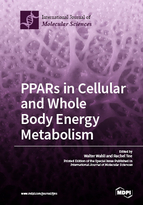PPARs in Cellular and Whole Body Energy Metabolism
A special issue of International Journal of Molecular Sciences (ISSN 1422-0067). This special issue belongs to the section "Biochemistry".
Deadline for manuscript submissions: closed (31 August 2018) | Viewed by 257887
Special Issue Editors
2. Center for Integrative Genomics, University of Lausanne, CH-1015 Lausanne, Switzerland
Interests: nuclear receptor superfamily; gene regulation and gene expression profiling; metabolic regulations; development; skin and wound healing; cancer; liver physiology; non-alcoholic fatty liver disease (NAFLD) and non-alcoholic steatohepatitis (NASH); adipose tissue; muscle and exercise; gut; microbiota; inter-organ cross-talk; nutrition; nutrigenetics and nutrigenomics
Special Issues, Collections and Topics in MDPI journals
Special Issues, Collections and Topics in MDPI journals
Special Issue Information
Dear Colleagues,
All three peroxisome proliferator-activated receptor (PPAR) isotypes α, β/δ and γ, function as sensors for fatty acids and fatty acid derivatives, and control important metabolic pathways regulating cellular and whole body energy homeostasis. These ligand-dependent transcription factors, which belong to the nuclear receptor superfamily of transcription factors, have been targeted to fight metabolic diseases based on their metabolic regulatory activities in various tissues, in part depending on ligand selectivity. In fact, PPARs act as modulators of cellular, organ, and systemic processes, including lipid and carbohydrate metabolism, making them valuable for maintaining body homeostasis, particularly under the influence of nutrition and exercise. Each organ has a unique metabolic arrangement. For instance, the metabolic patterns of the liver, muscle, brain, adipose tissue, and kidney, are markedly different and these organs strikingly differ in their use of fuels to meet their energy needs. Furthermore, tumours also have their own metabolic processes that differ from those of noncancerous cells. Lastly, the energy substrates have also specific characteristics that require adaptive strategies. This Special Issue of IJMS will cover the singular and intricate regulatory roles of all three PPAR isotypes in the ensemble of processes that are associated with metabolism in the healthy and diseased organism.
Prof. Walter Wahli
Ms. Rachel Tee
Guest Editors
Manuscript Submission Information
Manuscripts should be submitted online at www.mdpi.com by registering and logging in to this website. Once you are registered, click here to go to the submission form. Manuscripts can be submitted until the deadline. All submissions that pass pre-check are peer-reviewed. Accepted papers will be published continuously in the journal (as soon as accepted) and will be listed together on the special issue website. Research articles, review articles as well as short communications are invited. For planned papers, a title and short abstract (about 100 words) can be sent to the Editorial Office for announcement on this website.
Submitted manuscripts should not have been published previously, nor be under consideration for publication elsewhere (except conference proceedings papers). All manuscripts are thoroughly refereed through a single-blind peer-review process. A guide for authors and other relevant information for submission of manuscripts is available on the Instructions for Authors page. International Journal of Molecular Sciences is an international peer-reviewed open access semimonthly journal published by MDPI.
Please visit the Instructions for Authors page before submitting a manuscript. There is an Article Processing Charge (APC) for publication in this open access journal. For details about the APC please see here. Submitted papers should be well formatted and use good English. Authors may use MDPI's English editing service prior to publication or during author revisions.
Keywords
-
Peroxisome Proliferator-Activated Receptors (PPARs)
-
Energy homeostasis
-
Metabolic regulations
-
Organ cross-talk
-
Lipids and carbohydrates
-
Metabolic diseases
-
Cancer and reprogramming of energy metabolism
-
Systems biology








